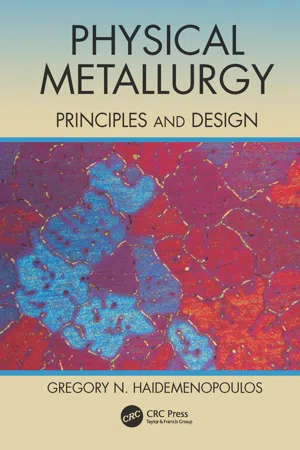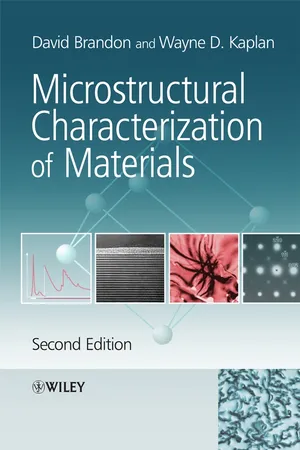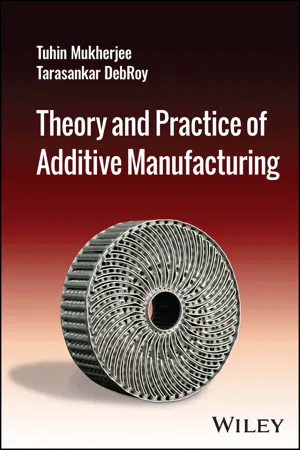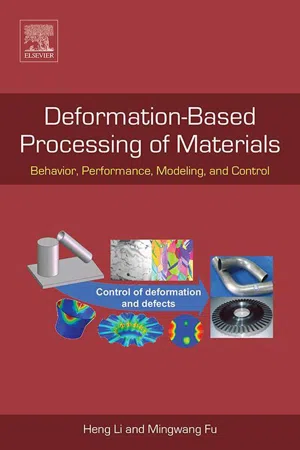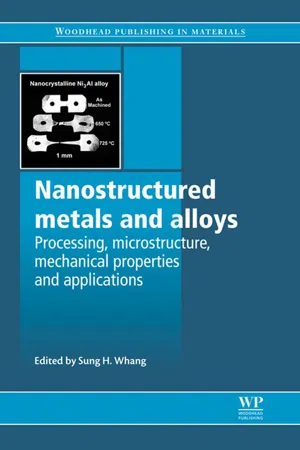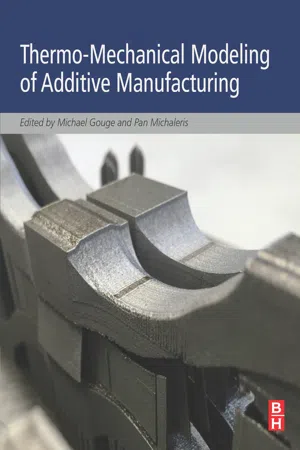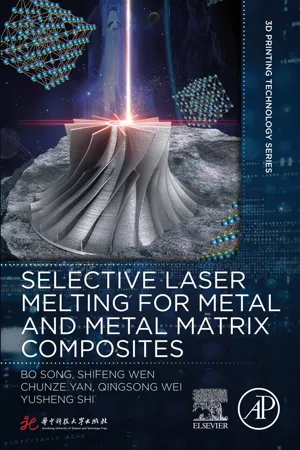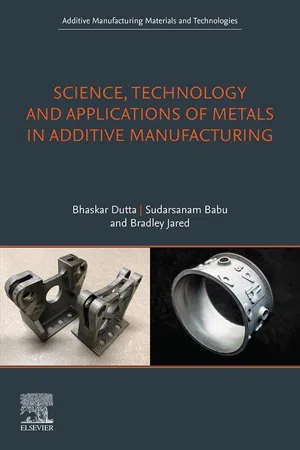Technology & Engineering
Microstructure of Metals
The microstructure of metals refers to the arrangement of grains and phases at a microscopic level within a metal. It includes the size, shape, and distribution of these grains, which greatly influence the mechanical and physical properties of the metal. Understanding and controlling the microstructure is crucial in engineering and manufacturing processes to achieve desired material properties.
Written by Perlego with AI-assistance
Related key terms
Related key terms
1 of 4
Related key terms
1 of 3
9 Key excerpts on "Microstructure of Metals"
- eBook - ePub
Physical Metallurgy
Principles and Design
- Gregory N. Haidemenopoulos(Author)
- 2018(Publication Date)
- CRC Press(Publisher)
alloy design . The principles of alloy design will be discussed in Chapter 12. However in order to understand the mechanisms of microstructural evolution, the fundamentals of thermodynamics and kinetics of structure should be discussed first.Figure 2.20: Basic elements of the microstructure: (a) schematic representation of microstructure, (b) grain boundary, (c) solid solution and vacancies, (d) plate-like coherent intermetallic compound, (e) spherical incoherent intermetallic compound, (f) edge dislocation.2.10 Thermodynamics and Kinetics of Structure
The structure of metals is not in a stationary state. It responds to external stimuli, such as a rise in temperature or plastic deformation. The structure responds with various processes ranging from the generation of new lattice defects to the change of crystal structure through phase transformations. Considering that a metallic alloy, with its current microstructure, constitutes a “system”, two questions are raised: Given the initial conditions, towards which direction will the system move, if an external stimulus is applied? How fast will the system move to that direction? The answer in the first question is given by thermodynamics while the answer to the second question is provided by kinetics . Thermodynamics defines the potential for a reaction or a transformation to take place while kinetics defines the rate of the reaction or transformation. The term “system” refers to an alloy, the structure of which consists of one or several phases. A phase is a part of the system with homogeneous structure, composition and properties. Each phase is physically distinct from any other phase in the system. In metallic alloys, the solid solutions and intermetallic compounds are the phases of the system. The components of the system are the elements (A ,B ,…), which constitute the alloy. The chemical composition of the alloy or a phase is defined by the atomic or weight fractions of the components. As an example consider a steel, at room temperature, containing 0.4wt % carbon. The components of the system are Fe and C . The phases present are ferrite and cementite. Ferrite is an interstitial solid solution of carbon in iron with BCC structure. Cementite is an intermetallic compound, which corresponds to the iron carbide Fe 3 C . The composition of ferrite is 0.01wt % carbon while the composition of cementite is 6.67wt% carbon. Now assume that the temperature is raised to 850°C . The alloy will respond with a change in crystal structure. Phase constitution is different at 850°C . The phases present are only one: austenite. Austenite is an intersitial solid solution of carbon in iron with FCC structure. The composition of austenite will be 0.4wt - eBook - ePub
Materials Selection for Design and Manufacturing
Theory and Practice
- Joseph Datsko(Author)
- 2020(Publication Date)
- CRC Press(Publisher)
Chapter 4MICROCONSTITUENT DIAGRAMS AND MICROSTRUCTURES
INTRODUCTION
The preceding chapters on crystalline structures and material phases form a background to the concepts of microconstituent diagrams and microstructures presented in this chapter. The subject of microstructures is very important because it serves as a means to analyze and compare the mechanical properties of all materials. The common alternative, as is frequently done, is simply to list separately for each family of materials the common treatments and resulting properties. That approach yields tables listing the properties of the various steels, and other tables for the aluminum alloys, and still others for the titanium alloys, but it cannot reveal the fundamental ties among each family of materials. When the treatments and properties of each type of material are discussed separately, the differences among them are emphasized. When the treatments and properties of materials are studied on the basis of microstructure, however, the similarities among them are emphasized. One big advantage of this latter approach is that instead of being forced to select a material on the basis of its properties for a few standard treatments, one can specify a treatment that will give the material optimal properties for a given part and application.MICROSTRUCTURES
Microstructure is the geometric configuration or grain structure of a polished and etched plane surface of a material as seen through an optical microscope. The usual magnification is 50 × to 1500×. Thus microstructure is an intermediate-size structure between the macro (with no magnification) scale and the atomic scale. The individual grains that make up the microstructure are called microconstituents.Although the terms phase, microstructure, and microconstituents are similar and related, they do not all mean the same thing. The term phase is used to identify a portion of a material system on the basis of chemical composition. Microsconstituent is used to identify a portion of a material system on the basis of its visual appearance, after polishing and etching, under an optical microscope. Microstructure - eBook - ePub
- David Brandon, Wayne D. Kaplan(Authors)
- 2013(Publication Date)
- Wiley(Publisher)
1
The Concept of Microstructure
This text provides a basic introduction to the most commonly used methods of microstructural characterization. It is intended for students of science and engineering whose course requirements (or curiosity) lead them to explore beyond the accepted causal connection between the engineering properties of materials and their microstructural features, and prompt them to ask how the microstructures of diverse materials are characterized in the laboratory.Most introductory textbooks for materials science and engineering emphasize that the processing route used to manufacture a component (shaping processes, thermal treatment, mechanical working, etc.) effectively determines the microstructural features (Figure 1.1 ). They note the interrelation between the microstructure and the chemical, physical, and/or mechanical properties of materials, developing expressions for the dependence of these properties on such microstructural concepts as grain size or precipitate volume fraction . What they do not usually do is to give details of either the methods used to identify microstructural features, or the analysis required to convert a microstructural observation into a parameter with some useful engineering significance.This book covers three aspects of microstructural characterization (Table 1.1 ). First, the different crystallographic phases which are present in the sample are identified. Secondly, the morphology of these phases (their size, shape and spatial distribution) are characterized. Finally, the local chemical composition and variations in chemical composition are determined.In all three cases we will explore the characterization of the microstructure at both the qualitative and the quantitative level. Thus, in terms of crystallography, we will be concerned not only with qualitative phase identification, but also with the elementary aspects of applied crystallography used to determine crystal structure, as well as with the quantitative determination of the volume fraction of each phase. As for the microstructure, we will introduce stereological relationships - eBook - ePub
- Tuhin Mukherjee, Tarasankar DebRoy(Authors)
- 2023(Publication Date)
- Wiley(Publisher)
Most parts hav polycrystalline structures although single-crystal components of some alloys have also been printed in laboratories. In polycrystalline components, the orientation of the crystals changes at the boundaries of the two adjacent grains. The grains have different shapes, sizes, and orientations. The primary and secondary phases, grains, and their shapes, sizes, and crystallographic orientations and defects define the microstructure of a component that affects the properties and serviceability of the part. In additive manufacturing (AM), a rapidly moving, intense, high-energy heat source melts the feedstock to form a molten pool (Figure 8.1). The evolution of microstructure starts with the nucleation of solids from the liquid. From the nucleating particles, grains of different crystallographic orientations begin to grow until the liquid transforms into one or more solids. These grains are of different shapes, sizes, and orientations which define the grain structure. Temperature variation in the solid region, often due to deposition of multiple layers, results in a change in shape and size of grains, precipitation of secondary phases such as metal carbides and nitrides, and solid-state phase transformation, such as austenite to ferrite transformation in steels. All of these features of the microstructure affect the properties of the parts. Characterization of these features requires sophisticated equipment to reveal them. The well-known characterization techniques of the microstructure of AM parts include optical microscopy, scanning electron microscopy (SEM), transmission electron microscopy (TEM), X-Ray and neutron diffraction, and synchrotron-based methods. These techniques are often time-consuming and expensive and do not provide the temporal evolution of the microstructural features in most cases - eBook - ePub
Deformation-Based Processing of Materials
Behavior, Performance, Modeling, and Control
- Heng Li, Mingwang Fu(Authors)
- 2019(Publication Date)
- Elsevier(Publisher)
The microstructure evolution in the deformation process depends on many physical metallurgical mechanisms, such as work hardening, damage evolution, change of crystallographic orientation, recovery, recrystallization, grain growth, phase transformation and precipitation, etc., and the occurrence of different phenomena will significantly affect the properties of formed parts [2]. For example, the crystallographic orientation and grain morphology determine mechanical properties such as anisotropy, strength, and toughness, and the phase composition and precipitation affect the physical and chemical properties such as electrical conductivity and corrosion resistance, etc. The deformation-related microstructure abnormalities mentioned here are different from the traditionally defined crystallographic imperfections. In general, crystallographic imperfections and defects can be divided into four types according to their geometry and shape: zero-dimensional point defects (vacancy and interstitialcy); one-dimensional line defects (dislocation); two-dimensional planar defects (grain boundary, phase boundary, twin, twist, stacking fault, and surface); and three-dimensional volume defects (void, pore, and crack). These defects are inherent in crystalline materials and have an important effect on the whole process of materials forming including solidification and plastic forming. The existence of crystallographic defects determines the macroscopic properties of materials, but do not always have negative impacts. Taking dislocation as an example, dislocation multiplication increases the material strength, while dislocation movement assists the plastic deformation of materials - eBook - ePub
Nanostructured Metals and Alloys
Processing, Microstructure, Mechanical Properties and Applications
- S H Whang(Author)
- 2011(Publication Date)
- Woodhead Publishing(Publisher)
778.11 (a) Transmission electron microscopy micrograph of nanocrystalline Fe powder. (b) Same micrograph with overlaying lines indicating planes of atoms. (c) Schematic of the plane structure with the location of the two disclinations identified.768.5 The effect of initial microstructure on deformation structures
The deformation structure formed in a given nanograined metal is highly dependent on the processing history of the metal and the resulting microstructure. This effect is true for all materials, but is of greater significance in nanograined structures due to their very high percentage of atoms not in stable lattice correlation. The variety of possible processing histories that can form nanograined structures can result in various percentages of free volume and types of grain boundaries within the microstructure. Characterization and testing of nanograined metals with the same purity and average grain size but created by different processing routes have shown that neither the microstructure nor the resulting mechanical properties of the two metals are equivalent.28 This suggests that the grain size distribution, types of defects present in the grains, and grain boundaries have a significant effect on the active deformation mechanisms and resulting mechanical properties. The microstructures formed during the production of nanograined materials can be controlled to contain many non-equilibrium structures, as demonstrated below.This effect can be clearly observed in a detailed study of the active deformation and failure mechanisms and properties of nanograined pulsed-laser deposited (PLD) Ni as a function of grain size. The three microstructures, seen in Fig. 8.12 , chosen for investigation were nearly monodispersed nanograined Ni film present in the as-released freestanding condition, Fig. 8.12 (a) and 8.12 (b) , the microstructure with maximized bimodal distribution, Fig. 8.12 (c) and 8.12 (d) , and the ultra-fine grained Ni films, Fig. 8.12 (e) and 8.12 (f) . The bright-field image, Fig. 8.12 (a) , of the as-released microstructure contains only nanograined Ni grains as confirmed by the select area diffraction (SAD) pattern insert that contains uniform rings of constant brightness, which is typical of fine-grained metals with no preferred texture. The histogram associated with Fig. 8.12 (a) , which quantifies the grain size distribution, is presented in Fig. 8.12 (b) . The average grain size ranged from 4 nm to 39 nm with a mean of 13 nm. This resulted in a standard deviation of 5.3 nm as can be seen in Table 8.2 . The vast majority of the 960 grains measured, 90%, are within the range of 5 nm and 20 nm. This results in a maximum grain size to average grain size ratio of 2.9. For comparison, the average grain size in these microfabricated samples is larger, and the distribution broader, than that in the as-deposited Ni films.78 - Michael Gouge, Pan Michaleris(Authors)
- 2017(Publication Date)
- Butterworth-Heinemann(Publisher)
Benefiting from the recent development of manufacturing tools and integrated platforms, AM has been successfully extended to the manufacturing of metallic materials [1 – 13]. Many industries, such as biomedical and aerospace, are being poised to benefit from the metallic AM. Some examples include (1) on-site, rapid fabrication of metallic bone implants with patient and injury-specific designs, and (2) fabrication of replacement parts in remote locations (e.g. outer space). However, in a technical aspect, a more comprehensive understanding on the “processing-microstructure-properties” correlation is still lacking for the metallic AM. The metallic AM process involves non-uniform temperature distributions and rapid thermal cycles that result in microstructures featured with porosity and anisotropy, which differ drastically from their cast or wrought counterparts. Such different microstructure features critically affect the mechanical properties of the AM builds. Therefore, understanding the microstructure development and evolution during the AM process of metallic alloys is an important prerequisite for the optimization of the AM parameters to achieve desired mechanical properties of the AM builds. 6.1 Microstructures in Additively Manufactured Metallic Alloys Microstructures are compositional and/or structural inhomogeneities developed during the processing of materials [14]. Microstructure evolution is a kinetic process to reduce the total free energies towards the thermodynamically equilibrium states in a material system under applied external fields [14]. Specifically, for AM of metallic alloys, the complex microstructure evolution characteristics arise from many aspects. On one hand, the multi-component, multi-phase nature of most of the commercial alloys enables the diverse microstructure patterns- Bo Song, Shifeng Wen, Chunze Yan, Qingsong Wei, Yusheng Shi(Authors)
- 2020(Publication Date)
- Academic Press(Publisher)
Chapter 3: Preparation and processing of metal materials
Abstract
This chapter introduces the microstructure and mechanical properties of typical metal materials like iron-based alloy, titanium-based alloy, aluminum alloy, and nickel-based alloy prepared by SLM, and studies Ti-6Al-4V metallic metamaterials, such as pentamode material (PM) structure. First, it analyzes and compares the formation law of melt pool morphologies and microstructure of these alloys under different process parameters, such as laser powder, scanning speed, layer thickness, and scanning distance. Second, it establishes the performance control method of SLM-formed parts by investigating how process parameters, scanning strategy, preheating, remelting, and postprocessing impact the mechanical properties. Eventually, it evaluates the mechanical properties of the Ti-6Al-4V metallic PM structures with different geometric parameters through experiments and a finite element model.Keywords
Metal materials; Microstructure; Mechanical properties; Process parameters; Performance control method3.1: Microstructure
3.1.1: Iron-based alloy
Iron-based alloys are hard-surface materials used in a wide range of applications; they provide good overall performance in a variety of uses, as well as low prices. At present, iron-based alloy materials formed by metal powder bed laser additive manufacturing technology mainly include AISI 304 L stainless steel [1] , AISI 316 L stainless steel [2] , AISI 420 stainless steel, and FeCr24Ni7Si2 austenitic heat-resistant steel [3] .- (1) AISI 304L
Figs. 3.1A and 3.2A show scanning electron microscopy (SEM) of SLM-processed 304 L stainless steel parts. Figs. 3.1B and 3.2B show energy dispersive spectroscopy (EDS) of the measured points. The results show that the microstructures of SLM-processed 304L stainless steel are columnar and fibrous austenites [1] .- (2) AISI 316L
Fig. 3.1- Bhaskar Dutta, Sudarsanam Babu, Bradley H. Jared(Authors)
- 2019(Publication Date)
- Elsevier(Publisher)
Chapter 5Microstructure and properties of additive manufacturing builds
Abstract
In this chapter, the roles of physical defects, microstructure evolution, and resulting properties with reference to metal additive manufacturing (AM) processes are discussed. Mechanisms related to defect formation are correlated to melt bead instability, surface roughness, and volumetric porosity, as well as, macro- and microcracking. In the first part of the chapter, microstructure evolutions in fusion-based AM processes are discussed based on ensuing phase transitions, including solidification and solid-state transformations due to multiple thermal cycles. Furthermore, the role of spatially varying chemical compositions on microstructure evolution is presented. These spatial variations of defect and microstructural distributions are then correlated to property scatter. Tensile, fatigue, and creep properties are discussed in detail based on published case studies. In the second part of the chapter, microstructure evolutions during solid-state AM processes are introduced. Case studies based on binder jet and ultrasonic additive manufacturing are presented to outline the underlying mechanisms. Some of the emerging solid-state manufacturing processes that are based on intense plastic deformations are introduced. Finally, the need to describe the spatial variations of microstructure and properties toward qualification of AM components for critical applications is justified.Keywords
Fusion-based metal AM; solid-state metal AM; solidification; solid-state transformations; dissimilar metals; crystallographic heterogeneity; microstructural variations; mechanical properties and hybrid materials5.1 Introduction
Currently there are many additive manufacturing (AM) processes that take material feedstock and convert it into a final component geometry dictated by a computer-aided design (CAD) file. As per the ASTM standards [1] for all AM processes, the metallic feedstocks in the filament or wire [2] , powder [3] , and sheet [4] can be dispersed through the use of a deposition nozzle, powder bed, or sheet stacks (see Fig. 5.1A ), respectively. In the next step, these materials are then bonded to themselves and also to the substrate either by (1) melting and solidification, (2) through solid-state joining, or (3) through powder metallurgy techniques involving sintering and metal infiltration [5] . The components can either be deployed after these single-step AM processes or subjected to multistep processes that include postprocess consolidation or heat treatments (see Fig. 5.1B
Index pages curate the most relevant extracts from our library of academic textbooks. They’ve been created using an in-house natural language model (NLM), each adding context and meaning to key research topics.
Explore more topic indexes
Explore more topic indexes
1 of 6
Explore more topic indexes
1 of 4
